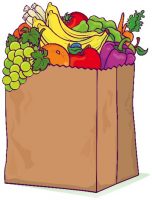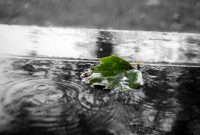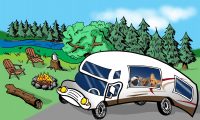
by admin | March 25, 2019 12:20 pm | By Doc Mueller, Main

There are just “So Many Things” to contemplate.
Yes, there are many things I have worked on over the years. It’s such a shame to waste them all… In making that statement, “I” am going to post as much of these ideas and information here as I can. My goal is to publish at least 5000 ideas. I’ll work on it for an hour or so every day! Come back often to see even more free ideas, information, fun things, jibberish, great links I’ve found for you, and just plain cool stuff. My collection includes art, articles, books, crafts, ebooks, how-to, recipes, quotes, experiences, just plain stuff, etc…
Now you will understand what it’s like to dabble in everything. You will just get a collection that is all over the platforms of humanity. You become an expert at nothing but everyone at least thinks you are well rounded and have a better-than-basic education 🙂 Or at least that is what you hope! 😉
In my many years of creating and loving change. Please share them with me; they are my gift to you. I would love for you to use my ideas and let my information, ideas, and tips help you every day of your life. Read a “funny” to have a break in a long day; nothing would please me more. As a bonus: (I hope you see it that way anyway) you can see inside my world of dogs, dogs, dogs. Which includes pictures of my favorite three little girls, dog toys, dog stuff, dog crazy, dog adventures (I think you get the dog point by now). Occasionally it would help me keep everything going on the site if you purchased one of my books, Information packages, or products. It will keep the site up, running and FREE. These idea pages give us a place to post all of our ideas. Making money is not my primary goal. It’s sharing… We all run out of that working capital eventually without help, but sharing is my goal. As we grow, you will find many links under the page titles. Some are links to our posts, and some go to outside links we have shared. I hope you find something here you love as much as I enjoyed sharing it. Doc Mueller (Cindy)
PLEASE feel free to send me “your stuff” as well. My goal is to find at least 5000 ideas to post here. Posting something from you would be a fantastic way to increase our pool of ideas.
by admin | March 2, 2020 10:05 am | By Doc Mueller, Cooking ideas, Environment, Main, Today's Thought
 This week, New York rolled out its’ ban on plastic bags. We all find much joy in not using plastic bags anymore, but is paper any better? Most of us want to band paper bags too and make everyone use reuse bags. (If we had to buy them at the counter to get our food home I’ll bet we would stop forgetting, I know I would☹
This week, New York rolled out its’ ban on plastic bags. We all find much joy in not using plastic bags anymore, but is paper any better? Most of us want to band paper bags too and make everyone use reuse bags. (If we had to buy them at the counter to get our food home I’ll bet we would stop forgetting, I know I would☹
I say: let’s ban paper bags too. Research by the UK Environment Agency has found that paper bag production requires more raw materials and energy, and produces more waste than plastic bag production.
14 billion trees are cut down annually for paper packaging; plastic ones are by-products of oil refining. It takes four times more electricity to  produce a paper than a plastic carrier. Besides, paper bag production emits 70% more air and 50% more water pollutants than its synthetic counterpart.
produce a paper than a plastic carrier. Besides, paper bag production emits 70% more air and 50% more water pollutants than its synthetic counterpart.
A paper bag has to be used at least three times to decrease its impact on the environment to match that of a plastic bag used just once.
New York joined the long line of jurisdictions that have banned plastic bags. Now there are about 66 countries and counting, Bangladesh was the first. The terrifying pictures we have all sen of plugged rivers or dead animals (from ingesting them) have made a mark on us all.
Globally, we produce around 300 million tons of plastic waste per year, which the UN has helpfully equated to the weight of the entire human population.
 Only a small part of this is recycled or incinerated. Almost 80% is merely piling up around us, as litter in our streets, in garbage dumps, and our waters. Depending on the type of product, plastic takes up to 600 years to decompose, all the while contaminating the water we drink and the food we eat. The UN estimates that by 2050, we could have more plastic than fish in our oceans and seas.
Only a small part of this is recycled or incinerated. Almost 80% is merely piling up around us, as litter in our streets, in garbage dumps, and our waters. Depending on the type of product, plastic takes up to 600 years to decompose, all the while contaminating the water we drink and the food we eat. The UN estimates that by 2050, we could have more plastic than fish in our oceans and seas.
Not all is lost, the reusable tote: Many people already have the habit of keeping them handy in our cars, handbags or backpacks and offices for that surprise trip to the grocery. The Environment Agency study estimated that reusable synthetic bags should be used up to 30 times to match the environmental impact of a plastic grocery bag used once, and canvas sacks at least 330 times. The idea is to go as natural as possible and to use them for years. Not only that, you can have them custom made for advertising your website, your business, your grandchildren, just about anything.
by admin | February 24, 2020 10:45 am | Main, Organization, Success, Well Being
 We all have areas where we want to improve; health, work, family, you name it. But reality sets in along with a busy schedule that doesn’t leave any space for quiet time, let alone individual development. We also rarely have the willpower we need to see it through. Or maybe we just don’t know where or how to start.
We all have areas where we want to improve; health, work, family, you name it. But reality sets in along with a busy schedule that doesn’t leave any space for quiet time, let alone individual development. We also rarely have the willpower we need to see it through. Or maybe we just don’t know where or how to start.
Not being able to define your own long-term goals will end up in a life that’s devoid of meaning or direction. You start losing that spark and the motivation to get up each morning wanes.
Experts define a personal growth plan as “the process of creating an action plan based on awareness, values, reflection, goal-setting, and planning for personal development within the context of a career, education, relationship or for self-improvement.”
An individualized growth plan can help you achieve the vision you have of yourself. It’s something we need to consciously think about and strive toward. If you don’t plan your own development and growth, no one else will.
Here are four steps you can take for a well-developed, easy-to-implement, personalized plan.
1. Know Thyself
In order to plan for the future, you have to reflect on your past experiences, your weaknesses, and strengths; they’ve made you who you are today. You also have to clarify your own unique values, such as integrity, respect for others, leadership, honesty. Your values define your stance, whether it’s at the workplace, with family and friends, and in your romantic relationships. Moreover, there are several essential questions you have to ask yourself:
- What do I want to become in life?
- What are my achievements up until now?
- What are my personal goals?
- What are my career ambitions?
- What steps have I taken to pursue these goals and ambitions?
2. Develop your vision
Once you’ve asked and answered these questions, you’ll have a clear idea of who you are and what you want out of life. This takes us to the second step; developing your vision. A smart tip is to provide yourself with several options to reach your next goal.
That way, if something goes wrong or you face an obstacle, you can switch to another path. Be flexible in your planning because usually, people tend to underestimate how long a particular project will take.
Another point people tend to not pay attention to is what they don’t want to do. If you’re at work, you can make a list of what-not-to-do, for example:
- Check emails as soon as they come in
- Keep too many tabs open at once
- Keep a cell phone on your desk
- Check social media while you’re working
3. Assess your present-day situation
Implementing your plan can be difficult at first. But with dedication and an eye on the prize, you’ll soon find that it becomes a daily habit. It was Jim Ryun who said, “Motivation is what get you started. Habit is what keeps you going.”
Putting your strengths to good use will harness your energy levels so that it’s utilized efficiently. You can set up milestones along the way because smaller goals give you the motivation and drive you to need to get to the big ones. And each time you reach a milestone or achieve one of the small goals, reward yourself for your hard work.
4. Review your progress
Each project needs to be reviewed and assess, and your exclusive growth plan is no different. You can do it on a monthly basis or every couple of months, whatever feels comfortable for you. But it’s crucial that you take a step back and look at all the hard work you’ve accomplished.
Check to see if you’ve left anything out or missed any deadlines. Or maybe the mini-goals you set up last time don’t fit your criteria any longer, they need tweaking or readjusting. Reflect on your experience and consider everything you’ve learned. This will ensure that you keep moving forward according to your long-term plan and the vision you’ve set up for yourself.
On a final note, you can draw up the perfect plan, but if you don’t follow through, you won’t get anywhere. Everyone needs the practice to develop and grow, even if it means stepping out of your comfort zone. Having something to strive toward can renew your self-confidence and passion for life.
by admin | February 17, 2020 9:43 am | By Doc Mueller, Main, Success, Tech, Today's Thought
 Years ago, I used to be a computer tech for dell. I had the A+ certification to help you with your issues on the phone etc. I was there when we were given the new software to go onto YOUR computer, and just do it for you was launched. This new prosses saved companies like Dell a fortune because no longer did they have to teach you to do it yourself. (Great for them, bad for you, most of the time.) In learning all this tech stuff, I found out that fixing computer issues was 10% knowledge and 90% being dam good at looking stuff up on the internet.
Years ago, I used to be a computer tech for dell. I had the A+ certification to help you with your issues on the phone etc. I was there when we were given the new software to go onto YOUR computer, and just do it for you was launched. This new prosses saved companies like Dell a fortune because no longer did they have to teach you to do it yourself. (Great for them, bad for you, most of the time.) In learning all this tech stuff, I found out that fixing computer issues was 10% knowledge and 90% being dam good at looking stuff up on the internet.
Jump to today! Now it seems that 50% (or more) of the help on the internet is outdated and that is only going to get worse as time goes on. Because the internet remembers everything and no-one goes back and deletes their old stuff because having all that on your blog etc.… makes your site look more active and well used. It also makes the site owner more of an “expert.”. My best tip for you today is LOOK AT THE DATE!!! If this article was written in 2016, it’s not going to help you. Try to go for help articles, step by step instructions, etc. That are less than one year old. That is still not a guarantee, but your results will be closer to the answer, I promise. If you have a really old computer look for dates around when you bought it. If it’s an internet thing like “How do I export my chrome bookmarks,” make sure it’s a current date.
by admin | February 10, 2020 9:16 am | Cooking ideas, Diet Tips ( I lost 160 LBS), Health, Main, Recipes, Well Being
 My former neighbor, Mary Young, a relatively new empty-nester, remarked on how free she feels with her nine kids out of the house. This feeling is common. Joy Smith, author of “,” encourages people to take advantage of it: “For the first time in years, you can cook because you want to, not because you must. You have fewer people and palates to please, so cook in ways you’ve never dared.”
My former neighbor, Mary Young, a relatively new empty-nester, remarked on how free she feels with her nine kids out of the house. This feeling is common. Joy Smith, author of “,” encourages people to take advantage of it: “For the first time in years, you can cook because you want to, not because you must. You have fewer people and palates to please, so cook in ways you’ve never dared.”
- Try new recipes. A majority of empty nesters say they enjoy exploring foods that their children would not eat, according to the July 2005 Pillsbury Empty Nester Survey.
- Think smaller. With just the two of you at home, there’s little need for family-size packages.
- Buy perishables with care. To reduce spoilage, buy only a few pieces of fruit and small amounts of vegetables at a time. Choose dairy products and fresh meats with the latest expiration date.
- Maximize nutrition. Pick foods that deliver the most nutrition for the bite. For example, broccoli (vitamins A and C), legumes (fiber) and fortified whole-grain cereals like Whole Grain Total®. As you get older, you need fewer calories but the same, or sometimes greater, amounts of key nutrients.
- Stock up on plastic containers. Prepare recipes that serve four or six and divide up the extra into two-serving portions. Label, date and refrigerate or freeze.
- Swap homemade dishes with a friend. It’s a great way to add variety to your menu.
- Get a new gadget. A vacuum sealer seals out air and preserves the moisture and flavor of the original dish. “I seal and freeze leftovers in one-meal portions for fresh-tasting dinners anytime,” suggests Smith. “Reheat in the microwave or boil in the bag on the stovetop.”
This recipe makes four servings, two for now and two for tomorrow.
Crunchy Garlic Chicken Breasts
11/3 cups Whole Grain Total® cereal
2 tablespoons chopped fresh parsley
1/2 teaspoon paprika
1/4 cup skim milk
2 teaspoons chopped fresh chives
1/4 teaspoon salt
1/4 teaspoon garlic powder
4 boneless skinless chicken breasts (about 11/4 lb)
Cooking spray
- Heat oven to 425°F. Spray 13×9-inch pan with cooking spray.
- Crush cereal. In a shallow dish, stir together cereal, parsley, and paprika. In another shallow dish, stir together milk, chives, salt, and garlic powder. Dip chicken into milk mixture, then coat lightly and evenly with cereal mixture. Place in pan. Spray top of chicken with cooking spray.
- Bake uncovered 20 to 25 minutes or until juice of chicken is clear when the center of thickest part is cut.
by admin | February 3, 2020 8:18 am | Holidays, Love, Main, Today's Thought, Well Being
Just to show you how wonderful I am I’m posting all these Valentine quotes. Maybe one will be just perfect for your valentine.












I hope One of these is the perfect fit for your Valentine!
by admin | January 27, 2020 9:08 am | Main
 Camping season “is” just around the corner so I thought I’d wrap up this month with a few of my camping tips for the gear you will need on your next camping trip. This is just one of those lists that keep you from making another list.
Camping season “is” just around the corner so I thought I’d wrap up this month with a few of my camping tips for the gear you will need on your next camping trip. This is just one of those lists that keep you from making another list.
If you are an avid camper, then you probably have everything set in stone as far as equipment goes. And better yet, you probably have a routine down pat. However, for those of you who are new to camping, here are some of the essentials and some things that you simply may not have thought of or remembered.
Shelter
The most important thing to have for your camping adventure is shelter. Shelter from the possible extremes is essential. Even if you are not surrounded by inclement weather, things such as spiders and snakes do exist and the need to protect yourself from them is all-important.
Of course, a little research goes a long way when first purchasing your tent. Ask your friends and family who have camping experience which brand they use and prefer. Go to many of the different sporting goods stores and even shop around online a little bit before settling into any one choice.
Camping tents come in various shapes and sizes:
* 2-person tent
* Family tent
* Dome tents
* Stand up tents
A great idea is to look into food tents once you have made up your mind which sleeping tent you want. Food tents can protect and preserve food against weather and animals as well. Keeping your food safely tucked away and far away from your sleeping quarters is an excellent idea.
Bedding
Once you have selected what size and style tent you desire, it is a good idea to purchase sleeping bags that are warm and waterproof. Also, think about buying a blow-up single mattress for those in your party who do not like “roughing it” as much. Pillows are another thought for comfortable sleeping.
Make certain to take along extra thermal blankets and sleeping bags to cover up in. It can get extremely cold up in many campsites, especially those surrounded by mountains.
Cookware
The location of your campsite will dictate how much and what to bring. If you are close to a food supply store, you can pack a little lighter. However, if you are really roughing it, you can always bring along canned and dehydrated food just in case.
* Camping stove with fuel and lighter or if you are bringing your barbeque, then charcoal, matches, and lighter fluid
* Frying pan with a lid
* Pot with a lid
* Cooking skewers
* Can opener
* Tongs for turning sausages and hot dogs
* Spatula for flipping burgers
Of course, paper plates, napkins, and utensils and cooking foil are a must, along with plastic cups. Don’t forget to bring tons of water.
Extras
You will also need to bring some extra miscellaneous items with you that you may not have thought of originally:
* Lanterns
* Flashlights
* Batteries
* Bug spray
* Sunscreen
* Flyswatters
* Garbage bags
* Soap, sponges, and scrubbers for dishes and a basin to wash stuff in
* Camping chairs
* A sewing kit
* Toiletries including toilet paper
* A car battery charger for your cell phone
These are just the basics to get you started on your camping adventure.
We camp from an RV, see our new site about camping coming soon to a page near you 🙂 https://www.rvingwithdoghousegypsies.com/






















Recent Comments